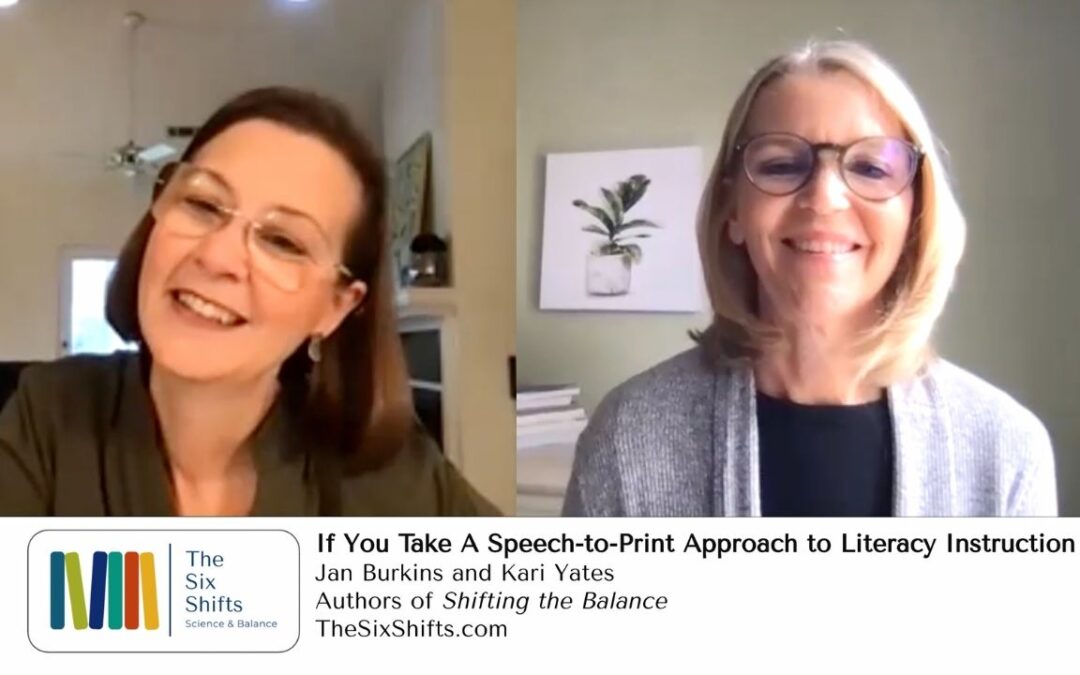If you approach learning to read and write as a speech-to-print -rather than as a print-to-speech – process, . . .
. . . then you will want to start by making sure children have strong oral language.
And if you are going to build children’s oral language, . . .
. . . then you’ll want to read aloud with lots of interaction, build knowledge in intentional ways, use rich and robust vocabulary, and give children lots of chances to engage in purposeful conversation throughout the day.
And if you’re building oral language as the foundation for literacy, . . .
. . . then you’ll also need to help children learn to take the whole words they are using in speech and break them down into their individual speech bits, or phonemes, through intentional phonemic awareness instruction.
And if children are developing phonemic awareness, . . .
. . . then you’ll also want to help them learn the special code that represents those speech bits by providing explicit and systematic phonics instruction, too.
And if you’re teaching both phonemic awareness and phonics, . . .
. . . then you’ll need to help children arrive at the critical moment of alphabetic insight.
This way they can fully leverage the bidirectional relationship between phonemes and graphemes to decode (read) and encode (write) written language.
And if children understand the alphabetic principle, having both an understanding of the code and phonemic awareness, . . .
. . . then you’ll be able to scaffold their orthographic mapping, helping them align the sounds in spoken language with their spellings.
And if they engage in lots of opportunities for orthographic mapping, . . .
. . . then they’ll be able to process and store words for efficient and automatic retrieval.
But if they are going to decode and map enough words to become truly fluent readers,
. . . then you will need to teach them to decode all the way through, not work around, the words they encounter in print.
And if you are teaching them to decode these words, . . .
. . . then you will want to stop prompting them to search for ways to figure out words by using context or looking at pictures.
And, if you are going to change your prompting, . . .
. . . then you will also need texts that actually set kids up for success as they practice decoding words and get their feet under them as readers.
And if you are going to use simple, decodable texts to help beginning readers get up and going, . . .
. . . then you will need to be more committed than ever to oral language development and knowledge building through read aloud, vocabulary development, and classroom conversation.
And if you’re committed to oral language development and knowledge building as a starting point for reading instruction, . . .
. . . then you will be taking a speech to print approach to helping children become readers and writers.
(Watch the video version HERE.)
____________________________
If you’re interested in learning more about critical shifts to early literacy instruction we invite you to:
- Visit our website at www.TheSixShifts.com
- Check out our book Shifting the Balance: 6 Ways to Bring the Science of Reading into the Balanced Literacy Classroom. Available at
- Listen to our six-part mini-podcast series here or wherever you get podcasts
- Join us in our online class, where we unpack each of the six shifts and their classroom implications in more depth
- Follow us on your favorite Facebook, Twitter, Instagram, or Pinterest @TheSixShifts



I do not see the print version of the circle story on the blog post or in the downloads. I am sure I am overlooking it somewhere.
It is in the body of the this blog post. 😊 https://thesixshifts.com/2022/01/if-you-take-a-speech-to-print-approach/